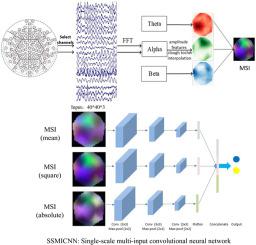Journal of Neuroscience Methods ( IF 2.7 ) Pub Date : 2021-09-04 , DOI: 10.1016/j.jneumeth.2021.109353 Dong Wen 1 , Zihao Cheng 2 , Jingjing Li 2 , Xinxiang Zheng 2 , Wang Yao 2 , Xianling Dong 3 , M Iqbal Saripan 4 , Xiaoli Li 5 , Shimin Yin 6 , Yanhong Zhou 7

|
Background
The application of deep learning models to electroencephalogram (EEG) signal classification has recently become a popular research topic. Several deep learning models have been proposed to classify EEG signals in patients with various neurological diseases. However, no effective deep learning model for event-related potential (ERP) signal classification is yet available for amnestic mild cognitive impairment (aMCI) with type 2 diabetes mellitus (T2DM).
Method
This study proposed a single-scale multi-input convolutional neural network (SSMICNN) method to classify ERP signals between aMCI patients with T2DM and the control group. Firstly, the 18-electrode ERP signal on alpha, beta, and theta frequency bands was extracted by using the fast Fourier transform, and then the mean, sum of squares, and absolute value feature of each frequency band were calculated. Finally, these three features are converted into multispectral images respectively and used as the input of the SSMICNN network to realize the classification task.
Results
The results show that the SSMICNN can fuse MSI formed by different features, SSMICNN enriches the feature quantity of the neural network input layer and has excellent robustness, and the errors of SSMICNN can be simultaneously transmitted to the three convolution channels in the back-propagation phase. Comparison with Existing Method(s): SSMICNN could more effectively identify ERP signals from aMCI with T2DM from the control group compared to existing classification methods, including convolution neural network, support vector machine, and logistic regression.
Conclusions
The combination of SSMICNN and MSI can be used as an effective biological marker to distinguish aMCI patients with T2DM from the control group.
中文翻译:

使用单尺度多输入卷积神经网络对 2 型糖尿病遗忘型轻度认知障碍的 ERP 信号进行分类
背景
将深度学习模型应用于脑电图 (EEG) 信号分类已成为最近的热门研究课题。已经提出了几种深度学习模型来对患有各种神经系统疾病的患者的 EEG 信号进行分类。然而,尚无有效的事件相关电位 (ERP) 信号分类深度学习模型可用于患有 2 型糖尿病 (T2DM) 的遗忘型轻度认知障碍 (aMCI)。
方法
本研究提出了一种单尺度多输入卷积神经网络(SSMICNN)方法来对患有 T2DM 的 aMCI 患者和对照组之间的 ERP 信号进行分类。首先利用快速傅立叶变换提取alpha、beta、theta频段上的18电极ERP信号,然后计算各频段的均值、平方和和绝对值特征。最后,将这三个特征分别转换成多光谱图像,作为SSMICNN网络的输入,实现分类任务。
结果
结果表明,SSMICNN可以融合不同特征形成的MSI,SSMICNN丰富了神经网络输入层的特征量并具有出色的鲁棒性,并且在反向传播阶段可以将SSMICNN的误差同时传递到三个卷积通道. 与现有方法的比较:与现有的分类方法(包括卷积神经网络、支持向量机和逻辑回归)相比,SSMICNN 可以更有效地识别来自对照组的 aMCI 和 T2DM 的 ERP 信号。
结论
SSMICNN 和 MSI 的组合可作为区分 aMCI 合并 T2DM 患者与对照组的有效生物标志物。











































 京公网安备 11010802027423号
京公网安备 11010802027423号